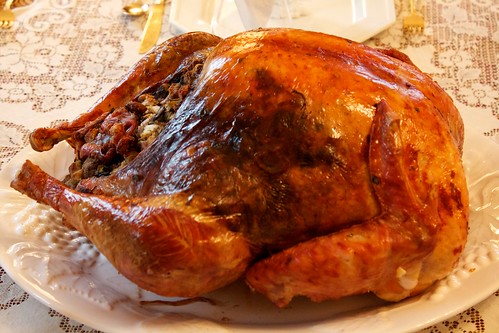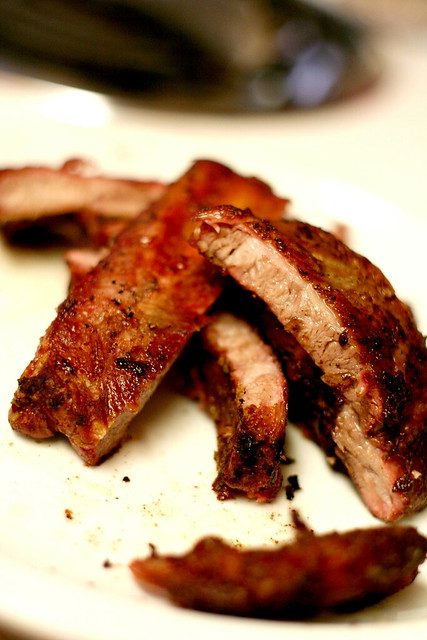I recently travelled to
Lenox, Massachusetts to the
Canyon Ranch resort, which is a spa dedicated to health and one's overall well-being. Each day there is a diverse schedule of activities and classes, which include various types of yoga,
Pilates, strength training, aerobics, dance, and even West African Drumming. In addition, guests at the Ranch can participate in many outdoor activities, such as guided bike rides of all levels, hikes, and canoe or kayak trips. In between all this activity, you'll find all sorts of lectures on well-being, cooking demonstrations, and of course, dozens of spa services designed to pamper. You certainly won't be bored during your stay, but you WILL work up quite an appetite each day. Luckily, the Canyon Ranch dining room is top notch (and one of my favorite parts of visiting!).
Canyon Ranch is a place promoting good health and good habits, so naturally, the dining room is committed to healthy eating. To say it is a "health food restaurant" would be doing it a disservice, because it is much more than that. Yes, the food is very healthy (they even give the calorie count, the fat content, and the fiber content for each and every item on the menu), but more importantly, everything tastes wonderful. The range of ingredients used in the kitchen is mind-boggling. Many ingredients are not ones most people are familiar with, so each trip to the dining room is a new adventure.
Jicama (pronounced HICK-a-ma),
quinoa (KEEN-
wa), and
tempeh (TEMP-
ee) are commonplace on the menu, but you'll also find lots of familiar food prepared in new, healthier ways too (roasted chicken, mashed potatoes, chili, and even baked
ziti!).
The chefs at Canyon Ranch also put many interesting twists on traditional recipes. For instance, instead of stuffing a chicken breast with bread stuffing, they stuff a small quail with blueberries (delicious!). Instead of pairing baby lamb chops with traditional garlic and rosemary, they are encrusted with a "
Zahtar" rub, which includes sesame seeds, sumac powder, thyme, and oregano, to name a few. They even find a way to make breakfast burritos interesting, by filling them with chicken sausage, steamed broccoli and low-fat cheddar cheese. Eating at the Ranch definitely can be a bit adventurous, but if you're willing to try a few new things, you'll find some new
combinations and flavors you may have never otherwise tried, but will certainly love.
Despite their strong commitment to healthy living, Canyon Ranch still understands the power of a sweet treat at the end of a meal. In addition to a daily fruit plate, you'll also find
chewy homemade cookies and homemade fruit sorbets and ice cream on the dessert menu. The ice cream (served with fat-free hot chocolate sauce) is rich and creamy, and is created in unusual flavors, including my favorite, Basil-Mint (out of this world!). There are also daily specials, which included delicacies like Raspberry Risotto Pudding, Boston Cream Pie, Chocolate Mousse, and Strawberry Shortcake during my visit. While many desserts are lower in fats and sugars than what we're used to, the chefs make no bones about the fact that the desserts aren't exactly health-food. The key is portion size. For those of you who love the
over sized desserts found at most American restaurants, you'll likely be disappointed, however I found the portions to be perfectly satisfying.
Canyon Ranch is definitely not all about the food--- it just happens to be one of the highlights of staying there. After a full day of yoga, biking, hiking, and perhaps a facial, you'll be more than ready for a wonderful, healthy, satisfying meal...that someone else prepares for you. Now that is a great day!
This is my version of a salad I enjoyed at Canyon Ranch. I added lean, white meat chicken for protein, and a balsamic vinaigrette for a little tangy kick. By omitting the dried fruits I found in the Ranch's salad, and adding fresh strawberries, I lowered the calorie count too (dried fruits are high in sugar and calories).
Simple Strawberry & Spinach Salad with Chicken Serves 44 cups baby spinach leaves, washed and dried
2 breasts of skinless, boneless chicken, cooked and diced
8 fresh strawberries, sliced
2 oz goat cheese
1/4 cup olive oil
1/4 cup balsamic vinaigrette
Salt and pepper
Divide the spinach onto four plates. Top with diced chicken and sliced strawberries.
Break apart the goat cheese and divide amongst the four salads.
Place balsamic vinegar in a measuring cup and while whisking, add olive oil in a slow drizzle to form a vinaigrette. Season with salt and pepper to taste.
Pass dressing in a small gravy boat or creamer, so guests can use as much or as little as they like.
Check out my website at
http://www.thesecretingredientonline.com/


































